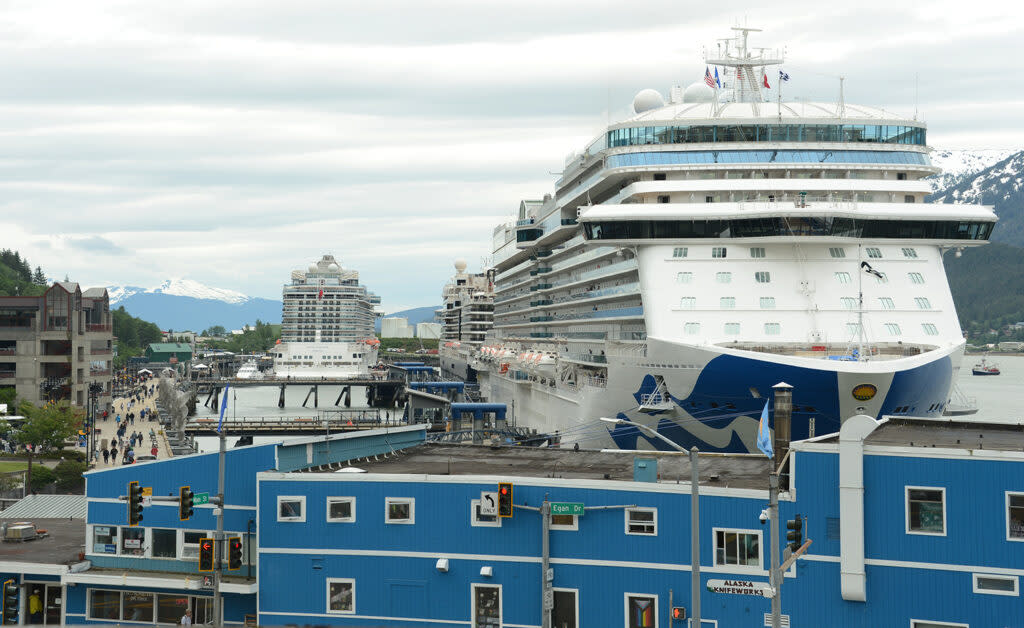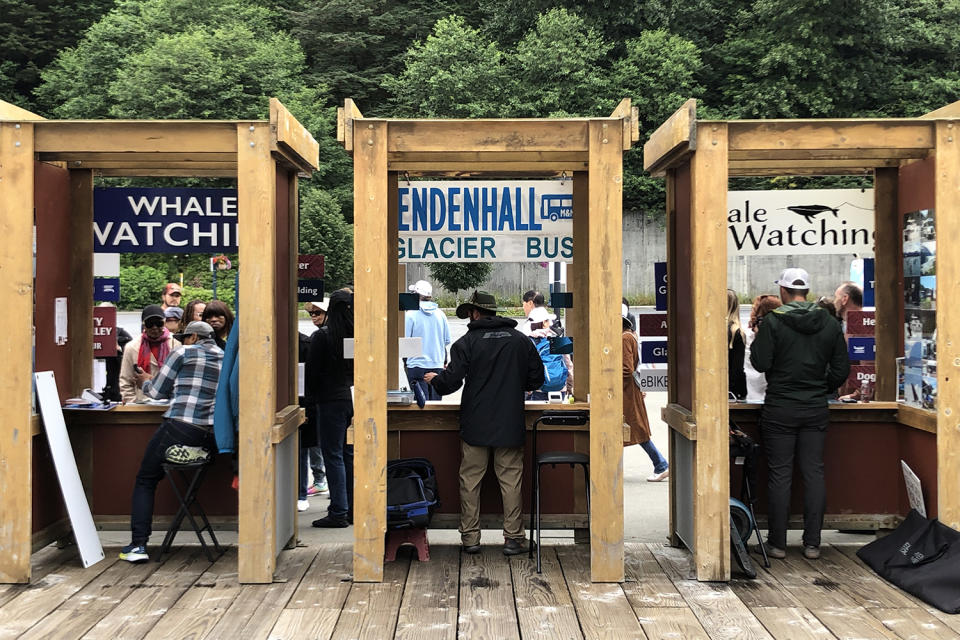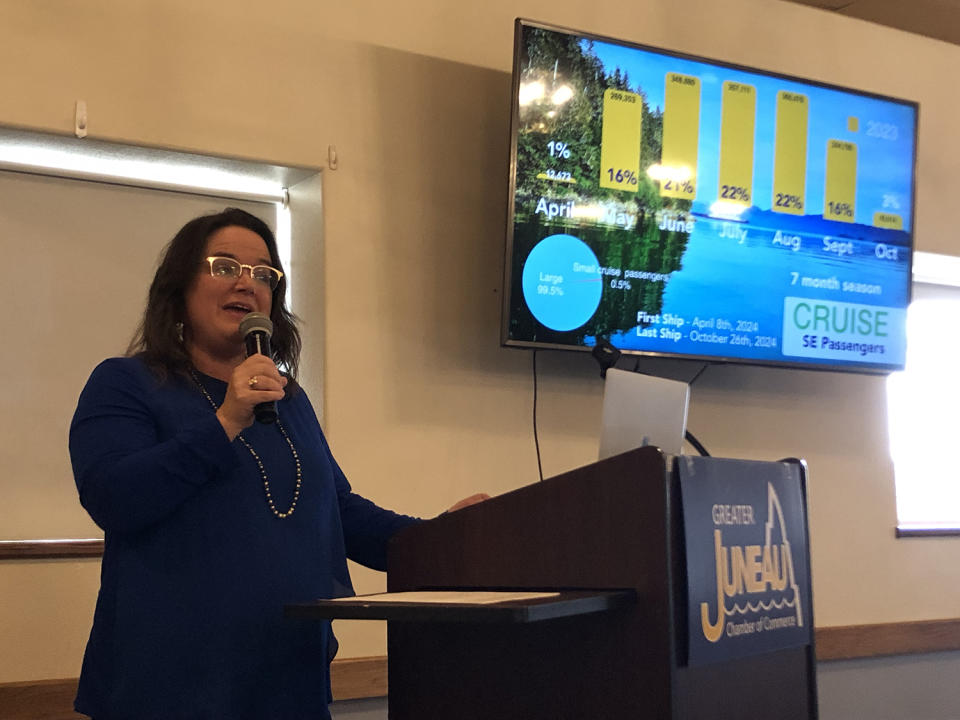Awash in tourists, Juneau prepares to turn some cruise ships away

Cruise ships line the Juneau waterfront on Wednesday, June 8, 2022. (Photo by James Brooks/Alaska Beacon)
Alaska’s state capital is set to become the first city in Alaska and one of only a handful in the United States to limit the number of daily cruise ship tourists.
Under the terms of a voluntary agreement announced Monday and effective in 2026, the nation’s four largest cruise lines will schedule ships containing no more than 16,000 standard beds in Juneau per day, what the industry calls “lower berths,” with the limit dropping to 12,000 on Saturdays.
The agreement comes after growing complaints by locals about overcrowding, housing shortages, noise pollution and air pollution.
“The goal and the message here is that Juneau is hitting pause on growth,” said Alexandra Pierce, the city’s tourism manager, of the agreement.
Because some ships sail above their listed capacity, the number of tourists allowed by the agreement may exceed 16,000 on some days, and that figure also doesn’t include visiting crew.
Some city residents say the agreement doesn’t go far enough to answer residents’ complaints, and they’re gathering petition signatures for a ballot measure that would ban cruise ships altogether on Saturdays.
One of the organizers of that measure, Karla Hart, said that even if the city’s agreement were for 12,000 or 5,000 people per day, it doesn’t give people a break from the cruise tourism season, which stretches from April through October.
“I’m still going to have helicopters flying over … there will still be whale-watching boats in numbers big enough that people can’t avoid those; all of the impacts of the industry will still be going even if there are some reductions in numbers of cruise passengers,” she said.
A counter-campaign, urging locals to not sign the petition, is already underway.
Juneau, a city of 32,000 residents, welcomes more than 1.6 million visitors annually, and on peak days, more than 21,000 tourists may visit by cruise ship.
By number of ships and number of visitors, Juneau is the most popular whale-watching destination in the world, the city claims. The Mendenhall Glacier Recreation Area, located within city bounds and operated by the U.S. Forest Service, is the most-visited tourist attraction in Alaska.
“The full-on cruise season in Juneau now is about 22 weeks long, which spans all of our summer plus our spring and our fall,” Hart said.
Travelers frequently spread out across the city, climbing aboard helicopters, boarding whale-watching boats and riding buses.
Hart described listening to strings of eight or more helicopters flying over her home.
“It’s every day that people who are in their own homes are interrupted and disturbed by helicopter noise,” she said. “Their enjoyment of their yard, of the trails around their home is disturbed by helicopter noise. And people who want to go out boating are disturbed or displaced or disrupted or endangered by a fleet of over 70 whale-watching boats … which creates horribly confused wakes and noise and disruption.”
Some businesses are already taking steps to mitigate the problems.
Wings Airways, which flies tourists via floatplane to a remote lodge, imposed its own limits on its operation, said Holly Johnson, a company vice president. It hasn’t grown its fleet of five airplanes.
“It’s something we’ve sort of always done behind the scenes, because it was the right thing to do for our business,” she said.
Wings is an exception: After the end of the COVID-19 pandemic emergency, the number of cruise tourists visiting Juneau grew by 40% from 2022 to 2023.
“That was shocking for people, and we had a lot of community reaction,” Pierce said.
She said the busiest days “have felt a bit suffocating for a lot of people and we’re trying to eliminate that and create some balance for the community.”
For the city, the difficulty has been balancing the interests of workers employed in the tourism industry with the needs of local residents who feel the consequences.
As far back as 2019, Juneau had convened a task force to consider a cap on the number of visitors, and current discussions began in March, she said.
Pierce said the new limit is designed to effectively hold tourist numbers steady, allowing businesses and the city to develop more infrastructure that spreads out the number of visitors, whether through new attractions like a summertime gondola planned for the city’s ski area, another cruise ship dock to spread out the crowd of arriving visitors, or changes to the Mendenhall Glacier site, planned by the Forest Service.
“Our goal is to make a million and a half people feel like a million people through infrastructure development,” she said.
By not having the cap take effect until 2026, cruise lines have time to reschedule their ships, said Renée Limoge Reeve, vice president of government and community Relations for Cruise Lines International Association Alaska.
Other ports in Southeast Alaska will also have time to anticipate the arrival of ships that otherwise might visit Juneau.
Juneau’s approach is a voluntary agreement, which differs from some approaches taken elsewhere. The city of Key West, Florida, passed several voter-approved ordinances putting hard limits on cruise ships, but those were vetoed by the state legislature and Gov. Ron DeSantis.
In Bar Harbor, Maine, locals installed a hard cap of 1,000 cruise ship passengers per day. A U.S. District Court judge upheld that limit after a legal challenge, but the case has been appealed.
In Alaska, the city attorney in Sitka rejected a Bar Harbor-like limit last year as unconstitutional under the language of the Alaska Constitution.
Juneau itself had an extended legal battle with the cruise industry over the use of head taxes paid by passengers. The city lost that case, which now limits how the city can spend passenger taxes.
That case, and the experience of other cities, encouraged Juneau to pursue negotiations and a voluntary cap. Pierce said that doesn’t mean the city will surrender to the industry if cruise lines decide to break the agreement.
Three of the four docks used by cruise ships in Juneau are city-owned, and in the worst-case scenario, “we’d say great, we’re closing our city docks,” Pierce said. “We do have a hammer. We just don’t want to use it.”
Meanwhile, Hart said she’s prepared to give Juneau residents the chance to vote on a tougher restriction. If the petition turns into a ballot vote this fall, she expects the resulting campaign could get “really ugly.”
Already, banners on some Juneau businesses are urging residents not to sign the petition.
“Our story is pretty clear,” she said. “It’s the lived experience of people. So we’ll just put in the work to give the community the chance to decide. And then it’s up to the community to decide. And we’ll see how it goes.”
Alaska Beacon is part of States Newsroom, a nonprofit news network supported by grants and a coalition of donors as a 501c(3) public charity. Alaska Beacon maintains editorial independence. Contact Editor Andrew Kitchenman for questions: info@alaskabeacon.com. Follow Alaska Beacon on Facebook and Twitter.
The post Awash in tourists, Juneau prepares to turn some cruise ships away appeared first on Washington State Standard.



